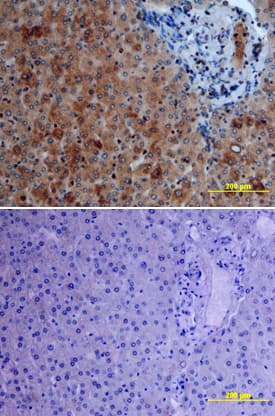Human/Mouse/Rat Raf-1 Antibody
R&D Systems, part of Bio-Techne | Catalog # MAB4540

Key Product Details
Species Reactivity
Validated:
Human, Mouse, Rat
Cited:
Human
Applications
Validated:
Immunohistochemistry, Simple Western, Western Blot
Cited:
Western Blot
Label
Unconjugated
Antibody Source
Monoclonal Mouse IgG2A Clone # 563002
Product Specifications
Immunogen
E. coli-derived recombinant human Raf-1
Asn189-Thr353
Accession # P04049
Asn189-Thr353
Accession # P04049
Specificity
Detects human, mouse, and rat Raf-1 at 74 kDa in Western blots.
Clonality
Monoclonal
Host
Mouse
Isotype
IgG2A
Scientific Data Images for Human/Mouse/Rat Raf-1 Antibody
Detection of Human, Mouse, and Rat Raf-1 by Western Blot.
Western blot shows lysates of MCF-7 human breast cancer cell line, HepG2 human hepatocellular carcinoma cell line, A431 human epithelial carcinoma cell line, L-929 mouse fibroblast cell line, and NRK rat normal kidney cell line. PVDF Membrane was probed with 1 µg/mL of Mouse Anti-Human/Mouse/Rat Raf-1 Monoclonal Antibody (Catalog # MAB4540) followed by HRP-conjugated Anti-Mouse IgG Secondary Antibody (Catalog # HAF007). A specific band was detected for Raf-1 at approximately 74 kDa (as indicated). This experiment was conducted under reducing conditions and using Immunoblot Buffer Group 3.Raf‑1 in Human Liver.
Raf-1 was detected in immersion fixed paraffin-embedded sections of human liver array using Mouse Anti-Human/Mouse/Rat Raf-1 Monoclonal Antibody (Catalog # MAB4540) at 15 µg/mL overnight at 4 °C. Tissue was stained using the Anti-Mouse HRP-DAB Cell & Tissue Staining Kit (brown; Catalog # CTS002) and counterstained with hematoxylin (blue). Lower panel shows a lack of labeling if primary antibodies are omitted and tissue is stained only with secondary antibody followed by incubation with detection reagents. View our protocol for Chromogenic IHC Staining of Paraffin-embedded Tissue Sections.Detection of Human Raf-1 by Simple WesternTM.
Simple Western lane view shows lysates of MCF-7 human breast cancer cell line, loaded at 0.2 mg/mL. A specific band was detected for Raf-1 at approximately 75 kDa (as indicated) using 10 µg/mL of Mouse Anti-Human/Mouse/Rat Raf-1 Monoclonal Antibody (Catalog # MAB4540) . This experiment was conducted under reducing conditions and using the 12-230 kDa separation system.Applications for Human/Mouse/Rat Raf-1 Antibody
Application
Recommended Usage
Immunohistochemistry
8-25 µg/mL
Sample: Immersion-fixed paraffin-embedded sections of human liver and human liver cancer tissue
Sample: Immersion-fixed paraffin-embedded sections of human liver and human liver cancer tissue
Simple Western
10 µg/mL
Sample: MCF-7 human breast cancer cell line
Sample: MCF-7 human breast cancer cell line
Western Blot
1 µg/mL
Sample: MCF‑7 human breast cancer cell line, HepG2 human hepatocellular carcinoma cell line, A431 human epithelial carcinoma cell line, L‑929 mouse fibroblast cell line, and NRK rat normal kidney cell line
Sample: MCF‑7 human breast cancer cell line, HepG2 human hepatocellular carcinoma cell line, A431 human epithelial carcinoma cell line, L‑929 mouse fibroblast cell line, and NRK rat normal kidney cell line
Reviewed Applications
Read 3 reviews rated 4.3 using MAB4540 in the following applications:
Formulation, Preparation, and Storage
Purification
Protein A or G purified from hybridoma culture supernatant
Reconstitution
Reconstitute at 0.5 mg/mL in sterile PBS. For liquid material, refer to CoA for concentration.
Formulation
Lyophilized from a 0.2 μm filtered solution in PBS with Trehalose. *Small pack size (SP) is supplied either lyophilized or as a 0.2 µm filtered solution in PBS.
Shipping
Lyophilized product is shipped at ambient temperature. Liquid small pack size (-SP) is shipped with polar packs. Upon receipt, store immediately at the temperature recommended below.
Stability & Storage
Use a manual defrost freezer and avoid repeated freeze-thaw cycles.
- 12 months from date of receipt, -20 to -70 °C as supplied.
- 1 month, 2 to 8 °C under sterile conditions after reconstitution.
- 6 months, -20 to -70 °C under sterile conditions after reconstitution.
Background: Raf-1
Long Name
v-raf-1Murine Leukemia Viral Oncogene Homolog 1
Alternate Names
c-Raf-1, Raf1, v-Raf-1
Gene Symbol
RAF1
UniProt
Additional Raf-1 Products
Product Documents for Human/Mouse/Rat Raf-1 Antibody
Product Specific Notices for Human/Mouse/Rat Raf-1 Antibody
For research use only
